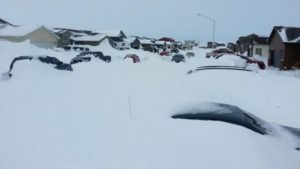
Written collaboratively by Laura Edwards and David Ollila.
As we remember the fifth anniversary of the winter storm and blizzard that occurred on Oct. 3–5, 2013 (which some call Winter Storm Atlas), the event provides a reminder that it is time to begin preparation and planning for winter weather events that can occur from now through May.
Fall Season 2018
By the end of September this year, freezing temperatures and snow had already occurred in the Black Hills. Many northwestern and north central areas have also reported sub-freezing temperatures. Large, rapid temperature fluctuations can occur in October and throughout the winter season. Rain can turn to snow and quickly begin accumulating, particularly in the fall and spring seasons as temperatures straddle the freezing mark. Climatological studies since the 2013 blizzard have shown that snow can often occur in October, but that year was a truly unusual exteme event, and there is no long-term trend towards earlier large snowstorms in western South Dakota.
This year, much of October will likely be marked with unusually cold temperatures and wetter conditions than we typically experience. Although no one is anticipating a blizzard like 2013, placing focused thought and developing winter storm plans that will ensure safety and security for both livestock and humans will reduce risk of injury or loss. At the same time, a winter storm plan can lessen anxiety and increase producer confidence that the storms will be weathered successfully.
Preparing for Winter Weather
What to consider when making weather preparedness plans:
Time of year. Fall and spring weather events tend to have more moisture in the snow along with ground surfaces that are not frozen. This combination can make areas where livestock concentrate “sloppy” and unsanitary, in addition to impassable roads to access livestock.
Consideration should be given to placement of supplemental feedstuffs which are in close proximity to where livestock are grazing or confined, as well as identified locations to provide natural and/or fabricated protection from weather elements. The ability to provide rumen contentment and wind protection will reduce livestock anxiety and stress. Feed placed nearby that can be made accessible without the need of large equipment will provide an immediate solution until roads and trails become more accessible for larger equipment.
As with all winter storms, in the event of impassable roads, loss of electrical power, necessary supplies should be obtained and stored for a potential extreme weather event that could endure for several days.
Suggested supplies and preparation considerations:
Plenty of diesel fuel, gasoline and propane stored to operate tractors, generators, heaters and vehicles.
Make certain to have alternative heat sources to maintain temperatures above freezing in your home, shop, and lambing/calving warming/tack rooms.
Generators can at the very least provide lighting and communication availability, but planning for refrigeration, heating and power to outbuildings, heated livestock waterers and feed handling equipment especially during calving and lambing become high priorities.
Animal health supplies should be adequately stocked during lambing and calving. Extreme weather can place great stress on young animals resulting in more animals experiencing life threatening infections.
Extreme weather preparation includes making pre-storm plans with your neighbors to insure that both human and livestock needs will be met before, during and following a storm.
Having an extreme weather preparedness plan active and in place will lessen the storm’s impact on livestock and infrastructure, while providing personal safety and financial security to the producer and their family during these unpredictable periods. For general winter weather safety information relating to snowstorms, blizzards, extreme cold and so on, visit the National Weather Service’s Winter Weather Safety website.
